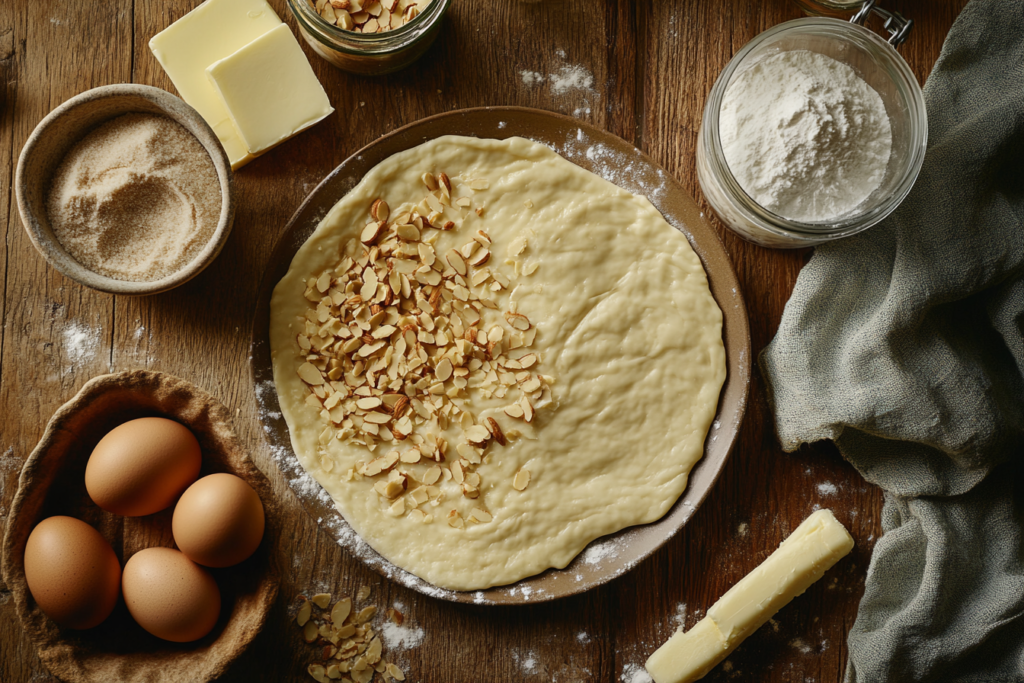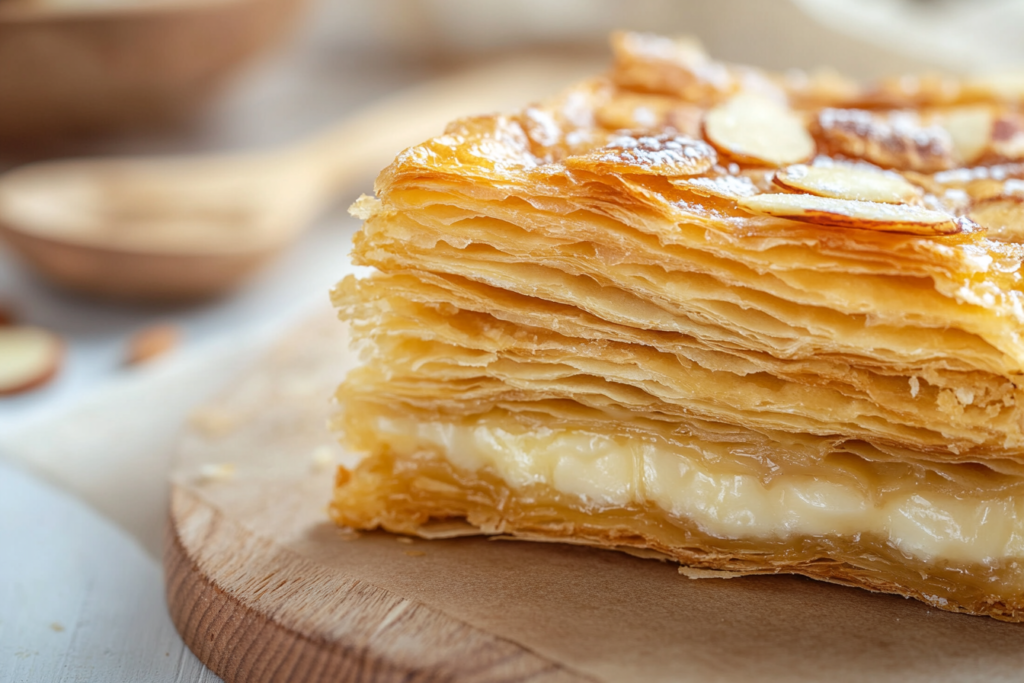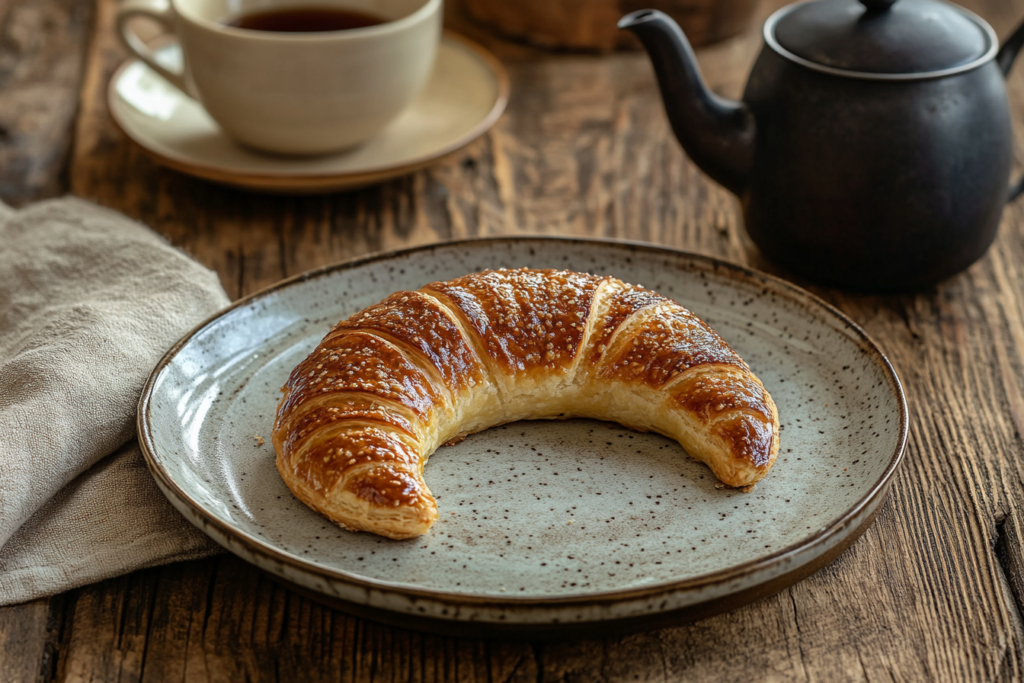Table of contents
- What is a Mandelgipfel? Introduction to This Swiss Pastry
- The Origin of Mandelgipfels: Swiss Almond Pastry History
- The Ingredients of a Mandelgipfel
- How Mandelgipfels Are Made
- Culinary Characteristics of a Mandelgipfel
- The Popularity of Mandelgipfels Globally
- Nutritional Profile of a Mandelgipfel
- How to Pair Mandelgipfels
- Mandelgipfels in Swiss Cuisine
- Variations of Mandelgipfel Recipes
- DIY Mandelgipfel Recipe
- Conclusion: The Future of Mandelgipfels
- FAQs About Mandelgipfels
What is a Mandelgipfel? Introduction to This Swiss Pastry
Ever strolled through the charming streets of Switzerland or visited a cozy Swiss bakery? You’ve likely seen a Mandelgipfel—a crescent-shaped, golden pastry, flaky on the outside, with a rich almond filling inside.
More than just a treat, a Mandelgipfel is a bite of Swiss tradition and comfort. Think of it as a nutty twist on the French croissant, simple yet elegant.
The name “Mandelgipfel” comes from German: “Mandel” means almond, and “Gipfel” translates to peak, reflecting its delightful crescent shape. Perfect for daily indulgence or special occasions, it’s a favorite with coffee or tea.
Tempted yet? Let’s explore the story behind Mandelgipfels, their origin, and why they’re loved worldwide.
The Origin of Mandelgipfels: Swiss Almond Pastry History
Swiss Roots and Cultural Importance of Mandelgipfels
The Mandelgipfel is deeply rooted in Switzerland’s culinary heritage. More than just a pastry, it symbolizes Swiss baking craftsmanship. While its exact origins remain unclear, many believe it evolved from European crescent pastries, eventually featuring the almond filling we know today.
In the 19th century, Swiss markets buzzed with bakers showcasing Mandelgipfels as a mark of their skill. Locals eagerly lined up to savor them fresh from the oven. Over time, these pastries became a beloved staple, enjoyed during morning commutes or festive gatherings alike.
Etymology of ‘Mandelgipfel’
The name itself tells a story. “Mandel,” as we mentioned earlier, stands for almond, which is the star ingredient in this pastry. And “Gipfel,” meaning peak, could symbolize its crescent-like shape that reminds one of a mountain peak—a fitting nod to Switzerland’s iconic Alpine landscape. Isn’t it fascinating how even a name can carry such a sense of place and tradition?
The Ingredients of a Mandelgipfel
Key Ingredients and Their Roles in a Mandelgipfel

What makes a Mandelgipfel so irresistible? It’s all about the ingredients! At its heart, you’ll find buttery, flaky pastry dough and a rich almond filling. Here’s a closer look:
- Pastry Dough: This is where the magic begins. The dough is laminated with layers of butter, creating the delicate, flaky texture that’s so characteristic of a Mandelgipfel.
- Almond Paste: Made from ground almonds, sugar, and sometimes a touch of cream, this filling is sweet, nutty, and creamy—perfectly complementing the crispness of the pastry.
- Egg Wash: A light brushing of egg wash gives the Mandelgipfel its golden, glossy finish.
- Optional Additions: Some recipes include a sprinkling of powdered sugar, sliced almonds on top, or even a drizzle of icing for added sweetness and flair.
Variations in Recipes Across Regions
While the traditional Mandelgipfel recipe remains a favorite, bakers across Switzerland and beyond have added their own unique twists. For instance, some might infuse the almond filling with a hint of vanilla or orange zest for a citrusy note. Others might use puff pastry for an even lighter texture.
Internationally, you’ll find creative variations too. In Germany, a Mandelgipfel might have a denser filling, while in France, bakers might experiment with marzipan. No matter the variation, the essence of the Mandelgipfel—a celebration of almonds and pastry—remains intact.
How Mandelgipfels Are Made
Traditional Recipe for Mandelgipfel
Ever wondered how these delightful pastries are made? Traditional Mandelgipfels involve several steps, but the result is well worth the effort. The process starts with preparing the pastry dough—often similar to croissant dough—by folding and rolling it with butter multiple times to create those signature layers.
The almond filling is prepared separately, blending ground almonds with sugar and a bit of liquid (like milk or cream) until smooth. Once the dough is ready, it’s rolled out, cut into triangles, and filled with the almond mixture before being shaped into crescents. A quick brush of egg wash, a sprinkle of almonds, and into the oven they go!
Modern Adaptations for Home Bakers
Don’t have the time to make laminated dough from scratch? No problem! Modern recipes often use pre-made puff pastry, making it easier for home bakers to whip up Mandelgipfels without compromising on taste. Simply roll out the dough, add the almond filling, and bake. It’s a shortcut, sure, but one that still delivers all the deliciousness of the original.
Table: Ingredients and Quantities for Traditional Mandelgipfel
| Ingredient | Quantity |
|---|---|
| All-purpose flour | 2 cups |
| Unsalted butter | 1 cup (cold) |
| Almond paste | 1 cup |
| Granulated sugar | 1/4 cup |
| Eggs | 2 (1 for filling, 1 for egg wash) |
| Milk or cream | 2 tbsp |
| Powdered sugar | Optional (for garnish) |
Culinary Characteristics of a Mandelgipfel
Flaky Texture and Almond Filling

What makes the Mandelgipfel truly unforgettable is its irresistible contrast of textures. Bite into one, and you’ll first notice the delicate, crispy flakes of the buttery pastry crumbling lightly against your lips. But as you move further into the center, you’re greeted with a creamy, smooth almond filling that’s perfectly sweet, nutty, and oh-so-satisfying.
This marriage of textures—flaky on the outside and soft on the inside—is what elevates the Mandelgipfel from a simple pastry to a culinary experience. Think of it as a warm hug for your taste buds, a moment where indulgence feels justified.
Appearance and Presentation
A classic Mandelgipfel is crescent-shaped, a nod to its name and tradition. Its golden-brown exterior gleams from the egg wash, often adorned with a sprinkle of powdered sugar or slivered almonds for that extra visual appeal. Some bakers take it up a notch with artistic drizzles of icing, giving it a festive vibe perfect for holidays or special gatherings.
Presentation matters, and the Swiss understand this well. A Mandelgipfel is more than just food; it’s a visual treat. Picture one served on a porcelain plate with a steaming cup of coffee or tea on the side—it’s the kind of moment that begs to be Instagrammed. But trust me, this pastry is best enjoyed without distractions, savoring every single bite.
The Popularity of Mandelgipfels Globally
How Mandelgipfels Are Enjoyed Around the World
Mandelgipfels may have originated in Switzerland, but their fame has spread far and wide. In Europe, they’re a popular pick at bakeries and cafes, often enjoyed as a breakfast pastry or an afternoon snack. In the U.S., they’ve started gaining traction among foodies who appreciate artisanal pastries with a story to tell.
Each country brings its own twist to the Mandelgipfel. In Italy, you might find them paired with a cappuccino for a light morning meal. In Japan, where European-style bakeries are trendy, Mandelgipfels are often adapted with matcha-infused almond fillings. The global love for this pastry is a testament to its universal appeal: buttery, nutty, and perfectly indulgent.
Seasonal and Festive Appeal
While Mandelgipfels are enjoyed year-round, they hold a special place during the winter holiday season. Picture this: snow falling outside, a roaring fireplace, and a platter of warm Mandelgipfels fresh from the oven. They’re a staple at Swiss Christmas markets, often accompanied by mulled wine or hot chocolate.
During festive occasions, bakers get creative, adding seasonal flavors like cinnamon, nutmeg, or even cranberry to the filling. These variations not only celebrate the season but also keep the tradition alive with a touch of innovation. If you’re ever in Switzerland during the holidays, do yourself a favor and try a freshly baked Mandelgipfel—it’s like tasting the spirit of the season.
Nutritional Profile of a Mandelgipfel
Calorie Content and Key Nutrients
Let’s be honest—Mandelgipfels aren’t exactly “health food.” But hey, who’s counting calories when you’re enjoying something this delicious? A standard Mandelgipfel contains approximately 250-350 calories, depending on its size and the ingredients used. The almond filling contributes healthy fats and a bit of protein, while the pastry dough offers carbohydrates for energy.
Here’s a rough breakdown:
- Fats: Most of the fat content comes from butter and almonds, offering a mix of saturated and unsaturated fats.
- Carbs: The pastry dough is carb-heavy, providing the energy boost we all need on busy mornings.
- Protein: Thanks to the almonds, there’s a small amount of protein, which helps balance the treat a little.
Balancing Indulgence with Healthier Options
While Mandelgipfels are an indulgence, there are ways to make them slightly healthier. For example, some bakers use whole wheat flour for added fiber or opt for a lighter almond filling with less sugar. Vegan Mandelgipfels (more on that later) often use plant-based butter, which can reduce saturated fat content.
As with any treat, moderation is key. Pair your Mandelgipfel with a cup of unsweetened tea or coffee to balance out the sweetness, and savor it as part of a balanced diet. After all, life’s too short to skip dessert, right?
How to Pair Mandelgipfels
Beverage Pairings (Coffee, Tea, etc.)

Ever wondered what drink goes best with a Mandelgipfel? The answer depends on your mood and the time of day. In the morning, a strong cup of coffee is the perfect companion. The bitter notes of coffee balance out the pastry’s sweetness, creating a match made in heaven.
Prefer tea? Opt for something light and aromatic, like Earl Grey or chamomile. The subtle flavors won’t overpower the Mandelgipfel but will still cleanse your palate. If you’re feeling indulgent, pair it with hot chocolate for a double dose of comfort. It’s a pairing that kids and adults alike will adore.
Complementary Foods (Jams, Fruits, etc.)
While a Mandelgipfel is a star on its own, you can elevate the experience by serving it with complementary sides. A dollop of raspberry jam or apricot preserve adds a fruity tang that contrasts beautifully with the almond filling. Fresh fruits like berries or sliced apples can also provide a refreshing balance to the richness of the pastry.
Feeling fancy? Serve your Mandelgipfels with a small cheese platter. The savory notes of cheese, especially something mild like Brie, pair surprisingly well with the nutty, sweet flavors of the pastry. Who says you can’t have a little gourmet fun with your snacks?
Mandelgipfels in Swiss Cuisine
Integration in Daily Meals
Mandelgipfels have carved a cozy niche in Swiss daily life. These pastries are not just reserved for fancy occasions—they’re a staple at breakfast tables, afternoon tea breaks, and even late-night snacks. In Switzerland, it’s common to grab a Mandelgipfel from a local bakery on the way to work or to enjoy one while catching up with friends at a café.
For many Swiss families, Mandelgipfels are more than just food—they’re a tradition. Some families even bake them together on weekends, turning the process into a cherished bonding activity. If you ever visit Switzerland, don’t be surprised if you see locals enjoying Mandelgipfels in almost every setting, from bustling train stations to tranquil Alpine retreats.
Role in Swiss Bakeries and Cafes
Walk into any Swiss bakery, and you’ll likely find rows of freshly baked Mandelgipfels, their golden crusts glistening under the display lights. Swiss bakeries take immense pride in perfecting this pastry, often using recipes that have been passed down for generations.
Cafes, too, play a significant role in the Mandelgipfel story. These pastries are a menu staple, often served alongside expertly brewed coffee or fragrant teas. Some upscale cafes even put a gourmet twist on Mandelgipfels, incorporating premium ingredients like organic almonds or artisanal butter. Whether you’re at a humble corner bakery or a chic café in Zurich, a Mandelgipfel is always a good choice.
Variations of Mandelgipfel Recipes
Vegan and Gluten-Free Mandelgipfels
Good news for those with dietary restrictions—you don’t have to miss out on the joy of Mandelgipfels! Many bakers have developed vegan and gluten-free versions of this classic pastry, ensuring that everyone can indulge.
For vegan Mandelgipfels, traditional butter is swapped for plant-based alternatives, and almond milk is used to create the filling. The result? A pastry that’s just as flaky and flavorful as the original, but entirely plant-based. Gluten-free versions typically use almond flour or a blend of gluten-free flours to recreate the delicate texture of the dough. Sure, it takes a little more effort, but the reward is a pastry that’s inclusive and delicious.
International Twists on the Recipe
As Mandelgipfels have gained popularity globally, bakers from different cultures have added their own flair. In the Middle East, for example, you might find Mandelgipfels filled with pistachio paste instead of almonds, offering a unique nutty flavor. In Asia, flavors like matcha or red bean paste are incorporated to give the pastry a local touch.
These international twists don’t stray far from the original—they simply highlight how versatile the Mandelgipfel can be. It’s a testament to how food transcends borders, connecting people through shared love for something delicious.
DIY Mandelgipfel Recipe
Step-by-Step Guide for Beginners
Ready to try your hand at making Mandelgipfels at home? Don’t worry—it’s easier than you think! Here’s a simplified step-by-step guide to get you started:
- Prepare the Dough: Start with a high-quality puff pastry if you’re short on time, or make your own from scratch for a more authentic experience. Roll it out into a thin sheet.
- Make the Almond Filling: Blend ground almonds, sugar, a dash of milk or cream, and a splash of vanilla extract until smooth. Adjust the sweetness to your liking.
- Shape the Pastry: Cut the dough into triangles, place a spoonful of almond filling at the base of each triangle, and roll them up into crescent shapes.
- Brush and Bake: Brush each pastry with egg wash, sprinkle with sliced almonds, and bake in a preheated oven at 375°F (190°C) for about 20-25 minutes, or until golden brown.
- Cool and Serve: Let the Mandelgipfels cool slightly before dusting with powdered sugar. Serve warm for the best experience!
Common Mistakes to Avoid
- Overfilling the Pastry: Too much filling can cause the dough to tear or leak during baking. Use just enough to create a balanced bite.
- Skipping the Egg Wash: This step is essential for achieving that glossy, golden-brown crust. Don’t skip it!
- Underbaking or Overbaking: Keep an eye on your Mandelgipfels as they bake. Overbaking can dry them out, while underbaking leaves the dough raw.
When exploring Swiss pastries, the Mandelgipfel shares a cultural and culinary space with other delicate European treats. For instance, those curious about the art of crafting crescent pastries might enjoy reading about the Gipfeli Recipe: A Step-by-Step Swiss Pastry Guide, which highlights another iconic Swiss creation. If the buttery layers of the Mandelgipfel intrigue you, understanding What is a Common Mistake in Croissants? Learn to Avoid It! offers valuable insights into achieving flaky perfection. Additionally, for those who appreciate versatile breakfast pastries, the classic pairing of almond notes with the warm comfort of baked goods resonates in recipes like Baked Scrambled Eggs for Sandwiches, a creative twist to elevate your mornings.
Conclusion: The Future of Mandelgipfels
As the world of baking continues to evolve, Mandelgipfels are not being left behind. Bakers are experimenting with new flavors, from salted caramel to dark chocolate, and even incorporating superfoods like chia seeds into the filling. These modern adaptations keep the Mandelgipfel relevant while still honoring its traditional roots.
FAQs About Mandelgipfels
What is a Mandel Croissant?
A Mandel Croissant is a buttery, flaky pastry filled with almond cream or paste, often topped with slivered almonds and powdered sugar. It’s a close cousin to the French almond croissant but typically has a crescent shape, which gives it a unique visual appeal. Popular in Swiss and German bakeries, it combines the richness of a croissant with the nutty sweetness of almonds, making it a perfect treat for any time of day.
What is a Nussgipfel?
A Nussgipfel is a Swiss pastry similar to a Mandelgipfel but filled with a nut-based mixture, often made from ground hazelnuts or walnuts. The name “Nussgipfel” translates to “nut peak” in German, reflecting its crescent shape and nutty filling. It’s slightly less sweet than a Mandelgipfel but just as indulgent, offering a warm, earthy flavor that pairs beautifully with coffee or tea.

